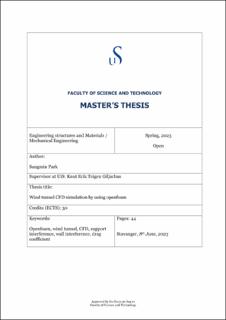| dc.description.abstract | Aerodynamics and fluid dynamics are used in many fields, such as aerospace, marine, and oil & gas. All these industries require precise results from experiments, tests, and simulations. This is because it is connected to considerable risks and losses. However, getting a perfectly correct answer in a fluid dynamic world is impossible. So, an approximation is used to solve unsolvable equations. This led people to simulate and test with CFD and wind tunnels. A wind tunnel is a test machine to test the fluid flow over the minimized object and expect how it will be in the real world. To test it in the real world, the size of the product is too huge and very expensive. Therefore, wind tunnel testing is essential.
This dissertation it was verifying CFD conducted processes by using Openfoam for the new wind tunnel at Universitetet i Stavanger. First, the log law of the wall was verified. This process was confirmed without any model inside the wind tunnel. After this verification, grid optimization and wall distance effect were done to reduce errors and check for any corrections. Pressure distribution, velocity distribution, and drag coefficient were used as criterion properties to check any difference in each case. The mesh size did not have any significant effect on the results. However, the wall distance affected the results because of the wall interference. Finally, support interference was carried out. Support interference is also one of the significant factors that can affect the result, as well as wall interference. These interferences are the most significant differences between the natural world and the wind tunnel. The existence of the supports behind the test model interrupted the vortex creation. Also boundary layer along the supports affected the pressure distribution. All these factors influenced the drag coefficient of the disk model. As a result, the drag coefficient decreased by 3%. This is because of the location of the supports. The supports must locate far away from the model so it does not affect the vortex formation. | |
